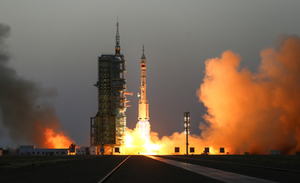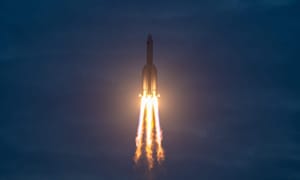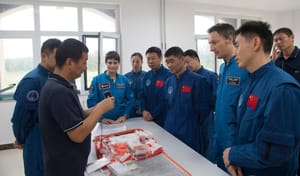
Oct 17, 2023
Celebrating 20 years of Chinese Human Spaceflight
On the 15th of October 2003, The People's Republic of China became the third country to successfully launch a person into Earth orbit using its own spacecraft and launch vehicles. The taikonaut, what China calls its astronauts, onboard the spacecraft for this mission was Yang Liwei, becoming the first person from China to go to space.
The Shenzhou-5 mission started at 01:00 am UTC on the 15th of October with the launch of a Long March 2F rocket from Jiuquan Satellite Launch Center and ended at 22:22 pm, twenty-one hours later, on the 15th of October.
The Shenzhou-5 Spacecraft

The Shenzhou-5 spacecraft and Yang Liwei made fourteen orbits around the Earth to, according to the China Manned Space Agency, test and examine;
"The manned environment, obtain the data relating to the living environment and safety of astronauts, and fully examine the operating performance, reliability and safety of each system as well as the coordination among various systems."
In its normal configuration, the Shenzhou spacecraft consists of a service module, a re-entry module, and an orbital module. During launch and return to Earth the crew are in the re-entry module which is the only part of the spacecraft that survives re-entry into Earth's atmosphere. The service module houses the main engines for the spacecraft as well as the two solar panels to generate power for the spacecraft. The orbital module houses the docking mechanism for the spacecraft and gives the crew additional room inside as well as space for cargo.
For the Shenzhou-5 mission, the orbital module contained automated experiments and stayed in orbit of Earth until the 30th of May 2004.
Who is Yang Liwei?

Yang Liwei, born on the 21st of June 1965, is currently the Vice Chief Designer at China Manned Space Engineering and previously served as a fighter pilot for the People's Liberation Army Air Force, obtaining the rank of Major General. Yang was chosen as a taikonaut candidate in 1998 and flew in 2003.
After the Shenzhou-5 mission, Yang received the title of 'Space Hero' from Chairman Jiang Zemin, The Gagarin Medal from Russia, and an honorary doctorate from the Chinese University of Hong Kong. Similar to what the Soviet Union did after the spaceflight of Yuri Gagarin, it was decided that Yang would not be assigned to any future spaceflight missions.
What's happened in the 20 years since?
Since Shenzhou-5 China has launched twenty-eight taikonauts into orbit, two single launch space stations, and built the modular Tiangong space station. The country now has its human spaceflight goals on performing space station science and the goal of putting a taikonaut on the moon by 2030!
To achieve its lunar goals China plans to launch two Long March-10 rockets, which is planned to make its maiden flight in 2027, for the mission. The Long March-10 is a three-stage rocket currently under development in China to carry up to 70 tons to low Earth orbit or 27 tons on a trans-Lunar injection. For the landing mission, China will launch a rocket carrying the lander on a trans-Lunar injection followed by the Next Generation Spacecraft carrying three Taikonauts.




